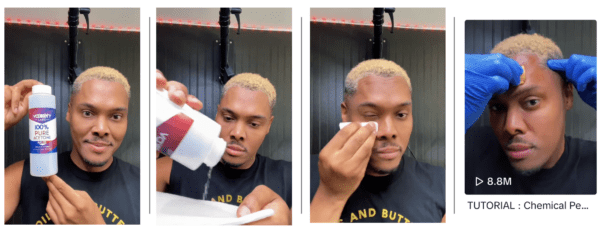We’re all looking at DIY facial treatments we can do at home to save a few pennies, with many of us turning to TikTok hacks. TikTok user @laoils shared a now viral video with 8.8 million views, which shows them using acetone before doing a DIY chemical peel.

After picking up our jaws from the ground, we spoke to Lisa Mason-Poyner, Director of Aesthetic Services at Élan Laser Clinics, and Kimberley Medd, Clinic Lead at Face The Future, for their expert opinion.
Lisa says, “A chemical peel is a skin-resurfacing procedure where a chemical solution is applied to the skin to remove the top layers, so the skin that grows back is smoother. Chemical peels are used to treat wrinkles, discoloured skin and scars — usually on the face. They can be done at different depths, from light to deep – deeper chemical peels offer more dramatic results but also take longer to recover from.
Whilst a very popular and effective procedure, it is not one I recommend someone attempt at home. It’s very important that you speak with a dermatologist or dermatological surgeon/aesthetician, and they perform the procedure, as results can be variable and depend on the person’s skin and also the expertise of the person doing the peel. If you’re inexperienced and the procedure is improperly done, a chemical peel can result in complications, including infection and permanent scars.
A chemical peel works best on clean, degreased skin, and most times this will be done by your medical aesthetician with cleansers or toners that contain glycolic acid or salicylic acid. As a strong and biocompatible solvent, it would seem that acetone would be a good choice for this purpose and whilst this might be the selected method for some, acetone used prior to chemical peeling removes not only the excess sebum that could impede peel penetration, but it also removes an unnecessary amount of the essential cholesterol and lipids from the skin. This tends to leave the skin over-stripped and dry post-procedure, and in the weeks following treatment. It is also not a solution that should ever be applied to the skin by someone who is not licensed to perform chemical peels.”
Kimberley says, “Whilst a chemical peel works best on clean, degreased skin, this will usually be done with exfoliating acids such as glycolic acid or salicylic acid, as anything stronger can cause the skin to feel fragile and weaken the skin barrier which is not what you want before a chemical peel.
A chemical peel causes a little damage to the skin’s protective barrier, which is totally normal and is repaired with proper aftercare that includes moisturising and hydrating the skin, as well as wearing SPF every day and using cold water.
Chemical peels should not be done on skin with a damaged skin barrier, and this will usually be discussed with the licensed professional performing the procedure. They will check your skin health and ensure it’s strong enough. Starting a chemical peel procedure with a strong formulation of acetone can immediately irritate the skin and impair the skin barrier before an already testing, yet effective, skin procedure.
Long-term skin contact with, and regular exposure to acetone can cause your skin to become dry, irritated, and cracked, and using it in large amounts can be harmful for the skin and can cause dermatitis.
Chemical peels are best performed by a licensed professional who will tailor pre-treatment steps, procedure and aftercare to your skin so that the chemical peel is as effective as possible with the best skin results.”
